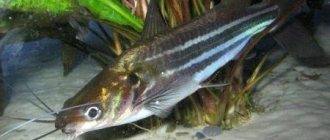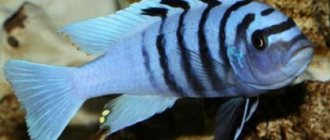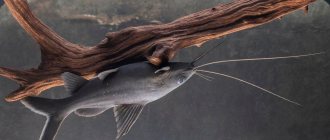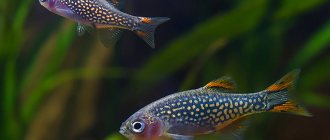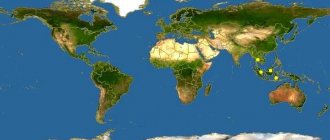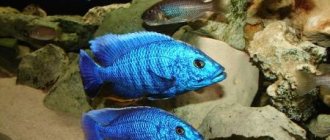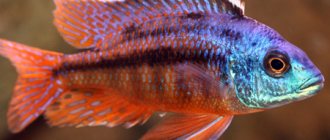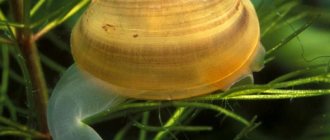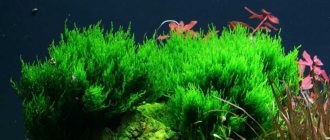Pseudotropheus pindani
Pseudotropheus pindani
Order, family: cichlids.
Comfortable water temperature: 24-28 °C.
Ph: 7,6-8,8.
Aggressiveness: 50% aggressive.
Compatibility: with cichlids.
Habitat : Lake Malawi.
Pseudotropheus pindani, also known as Sokolofi, also known as Sokolova, has an elongated and slightly compressed body at the sides. The size of the fish is up to 10 cm. Males and females have the same color; they can be distinguished by the size and shape of the anal fin. The body and fins have a uniform color: blue or light blue. The fins may have black stripes that are located at the edge.
The fish are moderately aggressive. You shouldn't put them with peaceful fish. The best neighbors would be similar cichlids (for example, Labidochromis yellow).
The minimum volume of an aquarium for a small group is 120 liters, the length must be at least 80 cm.
Comfortable water parameters for keeping: 24-28C, pH 7.6-8.8, dGH 10-25°. Aeration and filtration are needed, weekly changes of up to 1/3% of the water volume are recommended.
Males are larger and have longer dorsal and anal fins. In an aquarium, they usually grow up to 10-12 cm, females - up to 8-9 cm. Pindan falcons reach puberty at the age of 10-11 months, after which they bear offspring with enviable consistency, even in a general aquarium. In good aquarium conditions, pseudotropheus nightingales live up to 5 years.
Feeding aquarium fish should be correct: balanced, varied. This fundamental rule is the key to the successful keeping of any fish, be it guppies or astronotuses. The article “How and how much to feed aquarium fish” talks about this in detail; it outlines the basic principles of the diet and feeding regime of the fish.
In this article, we note the most important thing - feeding fish should not be monotonous; the diet should include both dry food and live food. In addition, you need to take into account the gastronomic preferences of a particular fish and, depending on this, include in its diet food either with the highest protein content or, conversely, with plant ingredients.
Popular and popular food for fish, of course, is dry food. For example, you can constantly and everywhere find food on aquarium shelves - the leader of the Russian market; in fact, the range of food for this Tetra is included as individual food for a specific type of fish: for goldfish, for cichlids, for loricariids, guppies, labyrinths, arowanas, discus, etc. .d. Tetra has also developed specialized foods, for example, to enhance color, fortified, or for feeding fry. You can find out detailed information about all Tetra feeds on the company’s official website - here .
It should be noted that when purchasing any dry food, you should pay attention to the date of its manufacture and shelf life, try not to buy food in bulk, and also store the food in a closed state - this will help to avoid the development of pathogenic flora in it.
Reproduction of pseudotropheus socolophy. Pseudotropheus socolofi reaches sexual maturity at the age of 10-12 months. The eggs are incubated in the female's mouth. During the spawning process, males and females begin to spin opposite each other. Due to the fact that there are yellowish spots on the anal fin of the male, somewhat reminiscent of caviar, the females that lay eggs and collect them in their mouths try to pick up something similar to caviar on the anal fin of the male.
When this happens, the male immediately releases a portion of sperm, which enters the female’s mouth and fertilizes the eggs located there. During the spawning process, one female spawns about 30-80 yellowish eggs. The eggs are incubated in the female's mouth for 18-22 days, after which the fry leave their mother's mouth for the first time. Producers are good parents, protecting the fry in every possible way from other fish. In the first days of life, the fry are fed cyclops, brine shrimp and other small crustaceans. The lifespan of Pseudotropheus Sokolov in aquarium conditions is about 5 years.
All of the above is just the fruit of observing this type of aquarium fish and collecting various information from owners and breeders. We would like to share with visitors not only information, but also live emotions that allow us to understand the world of aquariums more fully and subtly. Register at https://fanfishka.ru/forum/ , participate in discussions on the forum, create profile topics where you will talk about your pets in the first person and first-hand, describe their habits, behavioral features and content, and share with us your successes and joys, share your experiences and learn from the experiences of others. We are interested in every bit of your experience, every second of your joy, every awareness of a mistake, which makes it possible for your comrades to avoid the same mistake. The more of us there are, the more pure and transparent drops of goodness there are in the life and everyday life of our seven billion society.
Blue Pindani, or Pseudotropheus Socolofa
Pseudotropheus pindani is a small cichlid that lives in the shallow waters of Lake Malawi in Africa.
Juveniles of this Malawian species are colored sky blue, just like adult fish. There are two color variations: one is a completely blue fish, including fins; the second - the body of the fish and the fins are blue, but in the upper part of the dorsal fin there is a dark blue stripe and the first rays of the anal and ventral fins are also colored dark blue.
Habitat
Endemic to the African Lake Malawi, one of the largest on the planet. It is located on the border of the state of the same name Malawi, as well as Tanzania and Mozambique. This species inhabits the southern part of the lake. The natural habitat is characterized by rocky shores interspersed with sandy substrates.
Brief information:
- Aquarium volume - from 150 liters.
- Temperature - 25–29°C
- pH value – 7.6–9.0
- Water hardness - medium to high hardness (10–25 dGH)
- Substrate type - sand or gravel
- Lighting - moderate
- Brackish water - no
- Water movement - weak, moderate
- The size of the fish is 8–10 cm.
- Food - any plant-based
- Temperament - quarrelsome
- Keeping in a harem with one male and several females
- Life expectancy is about 8 years
Contents of Pseudotropheus Sokolof
It is best to keep these fish in a small harem, that is, one male and 2-4 females. If you add more males, then one dominant one will stand out, which will chase the rest, and quite bloodthirsty.
Pindani can easily coexist in the same aquarium with other Malawians, fighting back, for example, such “seasoned” cichlids as Demasoni or Auratus. If you keep these fish in one aquarium, then its volume should be at least 200 liters, better, of course, more.
The aquarium is decorated in a natural, rocky style. It is better to use a soil that will maintain a pH greater than 7, since Malawians do not live in acidic water. Marble or coral chips alkalize water well. In aquariums with these cichlids there must be a lot of hiding places, this will reduce the aggression of the fish.
Plants in such aquariums survive only with hard leaves, since Pindanis are herbivorous fish and tender leaves are often good food for them.
The water temperature for them should be within 24-27⁰C, hardness 8-25°, pH 7.5-8.5. Aeration and filtration of water are required, as well as its weekly replacement by 20% of the volume.
Maintenance and care, arrangement of the aquarium
To successfully keep a small group of adult fish, you will need a tank of 160 liters or more. The design usually uses a sandy substrate and piles of stones and rock fragments, from which shelters are formed in the form of caves and crevices. The presence of living plants is not necessary; they can be eaten by fish. Water conditions have high pH and dGH values. Placing a productive filtration system along with weekly replacement of part of the water with fresh water (10–15% of the volume) will allow maintaining hydrochemical conditions at the proper level. It is advisable to purchase filters with filter materials that increase water hardness to avoid strong fluctuations in dGH.
Feeding Pindani
Pseudotropheus pindani in nature feeds on algal fouling from rocks and coastal zooplankton. Therefore, when keeping Malawians in an aquarium, it is necessary to compose the diet so that most of it is plant-based. Nowadays there is a wide variety of food for herbivorous cichlids on sale, including those based on spirulina. You can also give lettuce, spinach, nettle, and dandelion leaves scalded with boiling water, but Malawians do not eat them particularly willingly, but they are very fond of various minced meats based on vegetables (cucumber, pumpkin, beets, zucchini, carrots, green peas, etc.) and herbs, which are prepared for them by caring lovers of African cichlids.
The best animal food for Pindanis to eat is krill, which they also eat in the wild. You can give Cyclops ice cream, pieces of shrimp, and squid. Such food must be given very limitedly; in principle, it is very difficult to overfeed plant foods.
Pindani gender differences
Pindani male and female
The body of males and females is colored the same, but the anal fin of the former often has eye-shaped yellow-white spots. Males are larger and have longer dorsal and anal fins. In an aquarium, they usually grow up to 10-12 cm, females - up to 8-9 cm. Pindans reach sexual maturity at the age of 10-11 months, after which they bear offspring with enviable consistency, even in a general aquarium. The female incubates the eggs in her mouth for three weeks, after which she releases the fry into the world, which are now able to feed on their own.
In good aquarium conditions, Pindani pseudotropheus live up to 5 years.
Description of fish
The body shape of pseudotropheus is torpedo-shaped. The maximum body length is 9-12 cm. There are large fleshy lips on the head. The mouth has special teeth for scraping algae from rocks. The dorsal fin starts from the head and extends all the way to the tail. Many species have a border on it. The anal fin has a pointed shape. It has oval spots of bright color. The caudal fin is single-lobed.
The color of fish can be different: yellow, blue, red, etc. It depends on the type of fish. All pseudotropheus have clearly visible transverse stripes on their bodies.
Fish live for about 10 years.
External characteristics
The fish has an elongated oval dense body covered with small scales. All fins are well designed: a powerful symmetrical tail, a long dorsal fin, large pectoral and anal fins. The elongated muzzle ends in a large mouth with plump lips. The mouth opens so well that small fish can easily fit into it. Pseudotropheus has a flexible spine, which allows it not only to swim in a straight line, but also to bend around rocks, moving nimbly and quickly. Huge round black eyes with a rim notice any prey. Pseudotropheus is a toothy predator that demonstrates high intelligence and aggression in the aquarium. Life expectancy in captivity is 8-10 years. How long these fish live depends on the conditions that the owner of the aquarium created for them.
Types of pseudotropheus
- Pseudotropheus demasoni are extremely aggressive babies. They grow to a maximum of 9 cm, but a pair of demasoni can conquer an aquarium measuring 180-200 liters. The main body color is dark blue, with blue stripes in the shape of irregular diamonds visible across it. The fins closer to the tail can be yellowish, sandy, or brown;
- pseudotropheus zebra - usually colored in shades of blue and blue, with thin transverse stripes running throughout the body. The dorsal fin has a dark blue edge. There are fish of other colors - red (females are red-orange, males are blue), white (snowflakes), blue, yellow. Zebra grows up to 12 cm;
- pseudotropheus lombardo are small fish (8-9 cm) with clear sexual differences: the male is orange-yellow with clear red stripes, and the female is blue-blue. They are considered aggressive and capricious, so the choice of neighbors for a pawn shop must be approached responsibly;
- pseudotropheus sokolov, blue pindani, blue pseudotropheus pindani - one of the non-aggressive representatives. Shy, when frightened or excited they become covered with purple spots. In a calm state, the fish is turquoise in color with iridescence. Can be kept in a school, but shelters are needed so that the fish can hide freely. Average size – 11-12 cm;
- pseudotropheus elongatus mpanga - can grow up to 30 cm in length. The large body is blue-violet in color with dark transverse stripes (from 5 to 12 pieces). Males have several round yellow spots on the anal fin. The tail and pectoral fins may have a yellowish tint. A dark stripe stretches along the edge of the dorsal fin;
- pseudotropheus atsei itungi - each scale has a main color of blue, as well as a darker border along the edge, which is why the fish appears variegated, in a blue-black mesh. All fins have a white edge: the dorsal fins are along the upper edge; the pectoral and anal fins have white first rays. The back is usually dark, the tail is bright yellow, with dark lower rays. The fish grows up to 15 cm and is quite peaceful;
- pseudotropheus atsei mzuli - the color arrangement is the same as that of the itunga, but different shades. Mostly the color is dominated by light colors: blue, gray, silver. The fins are bright yellow. The size of an adult fish is up to 15 cm;
- Pseudotropheus acei ngara is another geographical morph of acei. The fish is completely black, with white edges on the fins;
- pseudotropheus saulosi - the females of these fish are yellow, and the mature males are blue. In males, transverse stripes are clearly visible, the fins are almost black, with a thin white edging. In an aquarium they reach 10 cm and are considered aggressive and territorial;
- Pseudotropheus flavus - in nature, this is a small group of fish that lives around the island of Chinyankwazi in Lake Malawi. They are black-striped and grow up to 10 cm. These fish are almost never found in aquariums, since the part of the lake where they live is located in a conservation area and is not caught;
- pseudotropheus crabro, chameleon cichlid - yellow fish with transverse black stripes. Among aquarists they are called “bumblebee”. In Lake Malawi, these fish reach 18-20 cm in length. Aquarium representatives are smaller than natural ones - they grow up to 9 cm;
- Pseudotropheus fainsilver is an aggressive fish of blue color with dark transverse stripes. Despite their small size (up to 10 cm), they can beat all their neighbors to death in order to win territory from them. Demanding on maintenance conditions and water parameters.
Create an account
–>
Aquarium online store. Aquarium fish and plants, aquariums and equipment
This category includes freshwater aquarium fish
five sizes:
S
– small;
M
– standard;
L
– average;
XL
– large;
XXL
– very large. The upper limit of the fish size in centimeters can be found inside the product card.
Price: 650 rub.
are available
Buy Pseudotropheus pindani, Pseudotropheus Sokolov, Blue pindani (Pseudotropheus socolofi, Pseudotropheus pindani), L
Express delivery
How to keep pseudotropheus
Conditions of detention require mandatory registration of the bottom according to the rules. Shelters, caves, rocks, grottoes - all this is typical for an aquarium in a marine style (pseudo-sea). By complementing the design with white soil and a blue background, the aquarist will receive a very decorative biotope, comfortable for Malawian cichlids. It is also important to observe other parameters.
Arrangement of the aquarium
- aquarium volume – at least 180-200 liters. Many species cannot tolerate their relatives as neighbors, so it is permissible to combine several Malawians in one aquarium. With overpopulation, conflicts are inevitable, which usually end in the death of the weaker enemy. Therefore, housing aggressive pseudotropheus in a smaller volume is not allowed;
- soil – fine gravel with a fraction of 3-5 mm. Any colour. A natural shade or snow-white quartz is preferable;
- a filter for an aquarium with pseudotropheus is only possible externally: it copes well with a large volume, saturates the water with useful elements and removes organic matter well;
- aeration – standard, compressor, aeration must be done around the clock;
- lighting is moderate, with shaded areas. With a good lamp, the color of the fish becomes brighter and more advantageous;
- artificial plants can easily replace natural ones. Pseudotropheus is not averse to eating any living plants: gnawing and digging them up. In such conditions, plants become not a decoration, but a headache for the aquarist. If you still decide to create the most natural atmosphere possible, egg capsules, nemphaea, and echinodorus are suitable: they have a developed root system and dense leaves;
- the decor includes piles of stones (volcanic tuff and others), ceramic pipes, locks, and jugs. The main thing is to create as many shelters as possible so that there is enough for all the inhabitants of the aquarium.
Feeding
The basis of nutrition for Malawian cichlids is plant food in the form of specialized dry mixtures to maintain color and immunity. You can add live food - fresh and frozen: bloodworms, coretra, pollock fillet. Large representatives are pampered once a week with small fish, which cichlids happily catch, showing their hunting instincts. You should not overuse live food: Mbuna tend to refuse plant foods and eat only protein foods, which leads to obesity and early death. The aquarist’s task is to strictly monitor the balance of nutrients supplied with food.
Behavior and Compatibility
Aggressiveness is the main difference between most pseudotropheus. Males are especially militant: they zealously protect their favorite mink and can attack other representatives of their species. Some species are less aggressive (for example, Pseudotropheus pindani), while for others it is recommended to keep one male with 3-4 females. The female half is usually less aggressive, but there are also warlike representatives (for example, among the Demasoni).
Neighbors may only contain cichlids from Lake Malawi, comparable in size to pseudotropheus, or slightly larger. Small predatory fish will most likely be eaten.
Having reached sexual maturity, the moths become more active: they set up a nest and care for the females. The more shelters and the larger the volume of the aquarium, the higher the likelihood of different types of pseudotropheus living peacefully in the same “room”.
Since mbunas prefer to live near the bottom, cichlids from the upper layers can coexist with them.
Description and habitat
Pseudotropheus is a fish endemic to Lake Malawi, a real underwater laboratory of the world, where many unique and rare life forms exist.
These African fish belong to the family of predatory Cichlids and to the Mbuna group, which translates as “dwellers of the rocks” or “stone fish”. Pseudotropheus actually live in underwater rocks in shallow waters.
These fish are quite small in size (6-15 cm) and are distinguished by strange double-upper teeth.
The body is painted with dark transverse stripes. This is a territorial species; males actively defend their habitat. Females and juveniles live in small families.
Photo gallery of pseudotropheus:
Breeding and reproduction
Pseudotropheus reproduces in a home aquarium without the use of a separate spawning tank. Sexual maturity occurs at approximately 1 year of age.
The process of reproduction of pseudotropheus
These fish bear their young in their mouths. During one spawning, the male fertilizes up to a hundred eggs, after which the female collects them in her mouth. During this time (2-3 weeks) she does not eat anything. Therefore, preparation for spawning begins with intensive feeding.
For some time after birth, the fry are still attached to their mother: in case of any danger, they hide in her mouth. Male pseudotropheus may not be the most caring fathers and may eat weak and clumsy children. In addition, other inhabitants of the aquarium always perceive juveniles as prey. When spawning in a community aquarium, a maximum of 2-3 individuals survive to adulthood. Therefore, if there is a need to preserve more offspring, it is still recommended to place the female in a spawning area. The water parameters in it are similar to a general aquarium; the size can be significantly smaller (50-60 l).
When using a spawning tank, it is better to remove the female as soon as the fry begin to swim independently. They are fed with the usual junior grade starter food.
Aquarium water quality
This is a very important condition for keeping a flock of handsome starfish, since under natural conditions they live in lake water with stable parameters and are very sensitive to even minor deviations from the norm. In principle, this is the main difficulty in keeping these cichlids
It should be noted that the water in Tanganyika is clean, hard and slightly alkaline. This is exactly the chemical composition that needs to be maintained in the cichlid fish. So, the main parameters of water:
hardness from 10 to 20 degrees (it can be maintained at this level using limestone or marble);
temperature not lower than +25° and not higher than +27°;
acid-base balance 7.5–8.5 (slight shift towards alkalinity).
To control parameters, many aquarists draw up graphs where they record the results of testing water quality using special tests.
It should be borne in mind that even the most insignificant or sharp deviation from these parameters is undesirable. For example, a decrease in water temperature by only 2-3 degrees leads to a cold, and then to the death of fish.
The purity of the water must be maintained at all times. Therefore, a reliable high-capacity filter is needed (due to the size of the aquarium), and powerful biological filtration must be required: cichlids do not tolerate excessive doses of nitrates and nitrites at all.
Water changes to reduce the concentration of nitrogenous compounds should be carried out weekly and very carefully. The maximum amount of water replaced is 15% of the total volume.
In Tanganyika, lake water is highly saturated with oxygen, which means that constant intensive aeration is necessary in the aquarium.
Diseases and their prevention
Typically, adult Malawian cichlids have excellent immunity. But if the conditions of detention are violated, it may decrease and the appearance of diseases:
- fungal infections;
- bacterial foci;
- viral diseases;
- mechanical damage after fights with neighbors.
The disease manifests itself as lethargy, loss of shine in scales, ulcers on the body, and dropsy. Some parasitic infections (such as ichthyophthyriasis) are treated by adding medication to the water. Others (bacterial “Malawi disease”) are unfortunately incurable.
Prevention consists of regular aquarium maintenance, keeping equipment clean and quarantining all fish before adding them to the aquarium.
